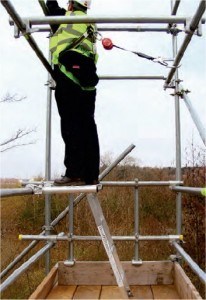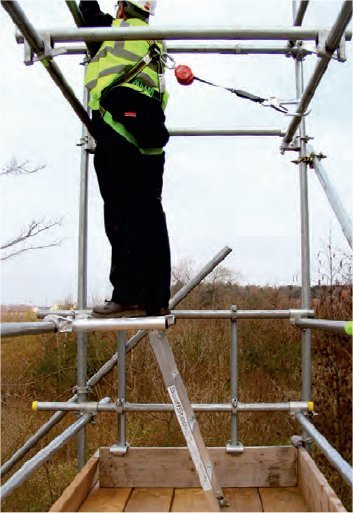 Due to the impending review of TG20:08 Volume 2, which is necessary following the introduction of the European Wind Code and the publication of BS EN1991-1-4:2005 A1:2010 (European Wind) and the National Annexe to BS EN1991-1-4:2005 A1:2010, all the safe height tables, text and diagrams associated with wind loading covered in TG20:08 Volume 2 are no longer valid and the tables detailed below should not be used, with immediate effect:
Tables being reviewed:
Table 29 – 31 (Pages 154 – 159) Safe heights for Basic independent tied scaffolds fully ledger braced with fully loaded inside boards.
Table 34 – 36 (Pages 165 – 168) Safe heights for Basic independent tied scaffolds part ledger braced.
Tables A1 – A24 (Pages 172 – 219) Appendix A – Tables of maximum safe eight for fully ledger braced Basic Scaffolds
Tables B1 – B12 (Pages 222 – 233) Appendix B – Tables of maximum safe height for part ledger braced Basic Scaffolds with line of ties at alternate lifts.
The NASC are currently reviewing the data associated with the wind load calculations and intend to issue revised data shortly. Until this time the NASC advises all users of TG20:08 – Volume 2 that the safe heights identified in the tables mentioned above will have to be determined from first principles.
For more information please visit the NASC website
Due to the impending review of TG20:08 Volume 2, which is necessary following the introduction of the European Wind Code and the publication of BS EN1991-1-4:2005 A1:2010 (European Wind) and the National Annexe to BS EN1991-1-4:2005 A1:2010, all the safe height tables, text and diagrams associated with wind loading covered in TG20:08 Volume 2 are no longer valid and the tables detailed below should not be used, with immediate effect:
Tables being reviewed:
Table 29 – 31 (Pages 154 – 159) Safe heights for Basic independent tied scaffolds fully ledger braced with fully loaded inside boards.
Table 34 – 36 (Pages 165 – 168) Safe heights for Basic independent tied scaffolds part ledger braced.
Tables A1 – A24 (Pages 172 – 219) Appendix A – Tables of maximum safe eight for fully ledger braced Basic Scaffolds
Tables B1 – B12 (Pages 222 – 233) Appendix B – Tables of maximum safe height for part ledger braced Basic Scaffolds with line of ties at alternate lifts.
The NASC are currently reviewing the data associated with the wind load calculations and intend to issue revised data shortly. Until this time the NASC advises all users of TG20:08 – Volume 2 that the safe heights identified in the tables mentioned above will have to be determined from first principles.
For more information please visit the NASC website
NASC withdraws safe height tables for Vol 2 of TG20:08
 Due to the impending review of TG20:08 Volume 2, which is necessary following the introduction of the European Wind Code and the publication of BS EN1991-1-4:2005 A1:2010 (European Wind) and the National Annexe to BS EN1991-1-4:2005 A1:2010, all the safe height tables, text and diagrams associated with wind loading covered in TG20:08 Volume 2 are no longer valid and the tables detailed below should not be used, with immediate effect:
Tables being reviewed:
Table 29 – 31 (Pages 154 – 159) Safe heights for Basic independent tied scaffolds fully ledger braced with fully loaded inside boards.
Table 34 – 36 (Pages 165 – 168) Safe heights for Basic independent tied scaffolds part ledger braced.
Tables A1 – A24 (Pages 172 – 219) Appendix A – Tables of maximum safe eight for fully ledger braced Basic Scaffolds
Tables B1 – B12 (Pages 222 – 233) Appendix B – Tables of maximum safe height for part ledger braced Basic Scaffolds with line of ties at alternate lifts.
The NASC are currently reviewing the data associated with the wind load calculations and intend to issue revised data shortly. Until this time the NASC advises all users of TG20:08 – Volume 2 that the safe heights identified in the tables mentioned above will have to be determined from first principles.
For more information please visit the NASC website
Due to the impending review of TG20:08 Volume 2, which is necessary following the introduction of the European Wind Code and the publication of BS EN1991-1-4:2005 A1:2010 (European Wind) and the National Annexe to BS EN1991-1-4:2005 A1:2010, all the safe height tables, text and diagrams associated with wind loading covered in TG20:08 Volume 2 are no longer valid and the tables detailed below should not be used, with immediate effect:
Tables being reviewed:
Table 29 – 31 (Pages 154 – 159) Safe heights for Basic independent tied scaffolds fully ledger braced with fully loaded inside boards.
Table 34 – 36 (Pages 165 – 168) Safe heights for Basic independent tied scaffolds part ledger braced.
Tables A1 – A24 (Pages 172 – 219) Appendix A – Tables of maximum safe eight for fully ledger braced Basic Scaffolds
Tables B1 – B12 (Pages 222 – 233) Appendix B – Tables of maximum safe height for part ledger braced Basic Scaffolds with line of ties at alternate lifts.
The NASC are currently reviewing the data associated with the wind load calculations and intend to issue revised data shortly. Until this time the NASC advises all users of TG20:08 – Volume 2 that the safe heights identified in the tables mentioned above will have to be determined from first principles.
For more information please visit the NASC website
Scaffolder Training Cards Explained
httpv://youtu.be/wi6eA2eUDv4
The CISRS (Construction Industry Scaffolders Record Scheme) is the only recognised training scheme for scaffolding operatives. The CISRS scheme is also the only recognised training scheme by the NASC (National Access and Scaffolding Confederation).
Scaffolding contractor fined after scaffold collapse
 The 48-year-old victim fell six metres and fractured his pelvis in four places after scaffolding built on behalf of David Knowles collapsed at a house in Nottingham, on 20 October 2009.
A safety investigation found the scaffolding had not been built by a competent scaffolder, was not erected to a standard configuration and had not been tied correctly.
Knowles was prosecuted for failing to ensure that people not in his employment were not exposed to risks to their health and safety.
After the hearing HSE inspector Mark Molyneux said: “Construction workers’ lives depend on scaffolds.
“Scaffold businesses must ensure their workers are trained and competent and that scaffolds meet the requirements and are tied correctly.
“If Mr Knowles had ensured the scaffolding had been properly planned and erected and tied by a competent person, this incident would never have happened and a man would not have suffered a painful injury as a result.”
Knowles, of Kirkby-in-Ashfield, pleaded guilty to safety breaches and was fined £5,000 and ordered to pay £3,944 costs.
Via: constructionenquirer.com
The 48-year-old victim fell six metres and fractured his pelvis in four places after scaffolding built on behalf of David Knowles collapsed at a house in Nottingham, on 20 October 2009.
A safety investigation found the scaffolding had not been built by a competent scaffolder, was not erected to a standard configuration and had not been tied correctly.
Knowles was prosecuted for failing to ensure that people not in his employment were not exposed to risks to their health and safety.
After the hearing HSE inspector Mark Molyneux said: “Construction workers’ lives depend on scaffolds.
“Scaffold businesses must ensure their workers are trained and competent and that scaffolds meet the requirements and are tied correctly.
“If Mr Knowles had ensured the scaffolding had been properly planned and erected and tied by a competent person, this incident would never have happened and a man would not have suffered a painful injury as a result.”
Knowles, of Kirkby-in-Ashfield, pleaded guilty to safety breaches and was fined £5,000 and ordered to pay £3,944 costs.
Via: constructionenquirer.com
Lorry wipes out scaffolding in Dorchester
 Eyewitness Scott Duncan said: “The whole lot just came down into the High Street.
“I thought it was a bit of an unusual sound, looked up and the scaffolding wasn’t on the front of the shop.”
Sgt Anita Arliss, of Dorset Police, said: “It appears the the lorry has been coming up High West Street, has attempted sharp right turn, has missed the turn and caught the scaffolding tower causing it to fall.”
The scaffolding was dismantled and removed and the road was later reopened.
Via: BBC
Eyewitness Scott Duncan said: “The whole lot just came down into the High Street.
“I thought it was a bit of an unusual sound, looked up and the scaffolding wasn’t on the front of the shop.”
Sgt Anita Arliss, of Dorset Police, said: “It appears the the lorry has been coming up High West Street, has attempted sharp right turn, has missed the turn and caught the scaffolding tower causing it to fall.”
The scaffolding was dismantled and removed and the road was later reopened.
Via: BBC ScaffMag Celebrates it’s 2nd Birthday
 Yes, it’s true ScaffMag.com the first and only scaffolding magazine is 2 years old today and what a two years it has been. But none of this would have been posable without you our loyal readers and our fantastic sponsors. I would like to take this opportunity to thank each and every one of you for your continued support.
Where did ScaffMag come from ?
Back in November 2009 I noticed our trade never had a paper or online magazine like others trades and I thought we needed one. So even though I was (and still am) a full time scaffolder I set about registering the domain and designing the site.
Two years on ScaffMag is stronger then ever with a huge database of helpful scaffolding content and a ton of scaffolding news from around the world. Our facebook page has built up a fan base of over 2,500 generating 210,000 post views per month. Don’t get me wrong ScaffMag still has a long way to go but I have never been more passionate about something than this digital magazine that unites scaffolders. Here is to the future… cheers.
ScaffMag SnapShots
Yes, it’s true ScaffMag.com the first and only scaffolding magazine is 2 years old today and what a two years it has been. But none of this would have been posable without you our loyal readers and our fantastic sponsors. I would like to take this opportunity to thank each and every one of you for your continued support.
Where did ScaffMag come from ?
Back in November 2009 I noticed our trade never had a paper or online magazine like others trades and I thought we needed one. So even though I was (and still am) a full time scaffolder I set about registering the domain and designing the site.
Two years on ScaffMag is stronger then ever with a huge database of helpful scaffolding content and a ton of scaffolding news from around the world. Our facebook page has built up a fan base of over 2,500 generating 210,000 post views per month. Don’t get me wrong ScaffMag still has a long way to go but I have never been more passionate about something than this digital magazine that unites scaffolders. Here is to the future… cheers.
ScaffMag SnapShots




SG4:10 Advanced Guard
S&B Version of an Advanced Guardrail System
httpv://youtu.be/cyXD_Ov-Py8
This is S&B version of an advanced guardrail system which they class as the “worlds first totally safe system.” What’s your opinion on this system? Let us know.
Scaffolders set up petition to ban the Scaff Step
 Scaffolders have concerns over the step causing extra strain on the back when lifting tube above the head to fix the advanced guardrail. There is also concerns with the plate that the scaffolder stands on becoming very slippery when wet.
The online petition can be found here Scaff Step Petition
On the Scaff Step petition website the introduction states:
Due to recent changes in the scaffolding industry (TG20:08), new legislation has been brought into force without consultation of the very people that have to abide by the new legislation.
Scaffolders have concerns over the step causing extra strain on the back when lifting tube above the head to fix the advanced guardrail. There is also concerns with the plate that the scaffolder stands on becoming very slippery when wet.
The online petition can be found here Scaff Step Petition
On the Scaff Step petition website the introduction states:
Due to recent changes in the scaffolding industry (TG20:08), new legislation has been brought into force without consultation of the very people that have to abide by the new legislation.
New UK Managing Director for Harsco Infrastructure
 Richard was previously the UK Managing Director of Cape Industrial Services Limited, he brings a wealth of experience and a proven track record across the construction, oil and gas, power, process and rail industries, in both commercial and operational capacities.
Prior to his position at Cape Industrial Services Richard was Group Commercial Director at Amec plc, a leading provider of consultancy, engineering and project management services to the infrastructure, energy and process markets.
Harsco Execuitve Vice President and Harsco’s Group CEO Ivor Harrington said:
“Richard’s appointment marks a significant step in the repositioning of this very important piece of the Harsco Infrastructure global business, and I am delighted to welcome him to our organisation.
“Richard’s combination of experience and expertise makes him ideally placed to help the continued growth and development of Harsco Infrastructure.”
Richard was previously the UK Managing Director of Cape Industrial Services Limited, he brings a wealth of experience and a proven track record across the construction, oil and gas, power, process and rail industries, in both commercial and operational capacities.
Prior to his position at Cape Industrial Services Richard was Group Commercial Director at Amec plc, a leading provider of consultancy, engineering and project management services to the infrastructure, energy and process markets.
Harsco Execuitve Vice President and Harsco’s Group CEO Ivor Harrington said:
“Richard’s appointment marks a significant step in the repositioning of this very important piece of the Harsco Infrastructure global business, and I am delighted to welcome him to our organisation.
“Richard’s combination of experience and expertise makes him ideally placed to help the continued growth and development of Harsco Infrastructure.” Embarrassing video gets press attention
httpv://youtu.be/O-mLXJAf09w
The video was originally sent to me via facebook by one of our facebook fans but found it’s way onto youtube once I viewed the video I knew it had to be featured in Video of the day section to show how not to promote ladder safety. Within two days Scaffmag was contacted by Morrison’s law firm Greenberg Traurig Maher LLP stating that we had to take the video down due to trade mark laws..?( “More like Morrison was very embarrassed about this video being posted on the internet and was trying to stop this video from spreading across the net and damaging Morrison’s safety reputation”), but this was in vain as the video went viral within hours on youtube. Today the media got hold of the story and is featured in all the major newspapers reporting that the safety officer Paul Cavanagh had not been seriously injured in the fall but had been suspended from his job for not following Morrison safety protocol by not anchoring the ladder to the wall. Chris Morgan the director of health and safety at Morrison posted a comment on youtube “We are dismayed by this isolated event, resulting from an individual deciding not to comply with our stringent H&S standards.” “This has led to suspension, pending investigation. We strive to ensure that everyone gets home safely, every day and are proud to have one of the lowest accident rates in sector. Please be sure that we have responded appropriately to this incident and that we will always endeavour to operate to the highest safety standards.” Written By Daniel NortonVideo of the day: Scaffolders Bowtime
We search the net to find some of the best scaffolding videos out there, some may be funny,serious or just weird but all will be noteworthy.. enjoy.
Scaffolders Bowtime:
httpv://youtu.be/bcHvh1tOGBE
Scaffolders from Brogans Group tell it how it is, they graft all day and then they are covered in dirt we help to construct the homes you live in and they hate getting wet. We have earned our Bowtime. Do you like this video ? well share it then below!






